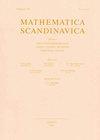局部动Brouwer度的可代表性
IF 0.3
4区 数学
Q4 MATHEMATICS
引用次数: 3
摘要
根据Kass和Wickelgren的工作,我们研究了哪些二次型可以表示为映射$f\colon\mathbb{a}^n\to\mathbb{a}^ n$的局部度,其中零为$0$,他们建立了与Eisenbud、Khimshiashvili和Levine的二次型的联系。我们的主要观察结果是,在一些基域$k$上,并不是所有的二次形式都可以表示为局部度。根据经验,映射$f\colon\mathbb{a}^n\to\mathbb{a}^ n$的局部度有许多双曲被加数,我们证明了事实上低秩局部度也是如此。我们建立了秩至多$7$的二次形式的完全分类,其可表示为在特征不同于$2$的所有基域上的映射的局部度。Eisenbud和Levine也研究了双曲被加数,他们在那里建立了双曲形式的数量的一般界限,这些双曲形式必须以可表示为局部度的二次形式出现。在秩为5的局部度的情况下,我们的证明方法是初等的和构造性的,而Eisenbud和Levine的工作更为普遍。我们提供了进一步的例子族,验证了Eisenbud和Levine的边界在几种情况下是紧的。本文章由计算机程序翻译,如有差异,请以英文原文为准。
Representability of the local motivic Brouwer degree
We study which quadratic forms are representable as the local degree of a map $f \colon \mathbb{A}^n \to \mathbb{A}^n$ with an isolated zero at $0$, following the work of Kass and Wickelgren who established the connection to the quadratic form of Eisenbud, Khimshiashvili, and Levine. Our main observation is that over some base fields $k$, not all quadratic forms are representable as a local degree. Empirically the local degree of a map $f \colon \mathbb{A}^n \to \mathbb{A}^n$ has many hyperbolic summands, and we prove that in fact this is the case for local degrees of low rank. We establish a complete classification of the quadratic forms of rank at most $7$ that are representable as the local degree of a map over all base fields of characteristic different from $2$. The number of hyperbolic summands was also studied by Eisenbud and Levine, where they establish general bounds on the number of hyperbolic forms that must appear in a quadratic form that is representable as a local degree. Our proof method is elementary and constructive in the case of rank 5 local degrees, while the work of Eisenbud and Levine is more general. We provide further families of examples that verify that the bounds of Eisenbud and Levine are tight in several cases.
求助全文
通过发布文献求助,成功后即可免费获取论文全文。
去求助
来源期刊

Mathematica Scandinavica
数学-数学
CiteScore
0.60
自引率
0.00%
发文量
19
审稿时长
>12 weeks
期刊介绍:
Mathematica Scandinavica is a peer-reviewed journal in mathematics that has been published regularly since 1953. Mathematica Scandinavica is run on a non-profit basis by the five mathematical societies in Scandinavia. It is the aim of the journal to publish high quality mathematical articles of moderate length.
Mathematica Scandinavica publishes about 640 pages per year. For 2020, these will be published as one volume consisting of 3 issues (of 160, 240 and 240 pages, respectively), enabling a slight increase in article pages compared to previous years. The journal aims to publish the first issue by the end of March. Subsequent issues will follow at intervals of approximately 4 months.
All back volumes are available in paper and online from 1953. There is free access to online articles more than five years old.
 求助内容:
求助内容: 应助结果提醒方式:
应助结果提醒方式:


